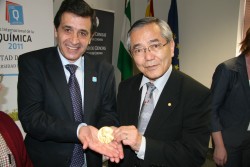
These complex molecules generated by catalysis have a wide application in very diverse fields, from agriculture to the pharmaceutical sector, the chemical industry or for electrical components. But uniting carbon atoms entails great difficulties for which we turn to a series of intermediate tools such as palladium-catalysed cross-coupling where the atoms of the palladium make a ‘meeting point’ between the carbon atoms. Negishi also referred to the fact that high-value metals, which we often use for jewellery, have been discovered to be important catalysers, signalling, as an example, the catalysers in cars that use platinum, iridium or rhodium, topics that he would touch upon, together with many others, in his later dialogue with more than twenty young researchers.
Negishi, who showed himself to be approachable and cordial throughout, was photographed with teachers and students showing his Nobel Prize Medal that he carried with him and which everybody was allowed to hold for a few seconds. The Nobel laureate, who tomorrow, at 12 o’clock, in the auditorium of the Rabanales campus will give a conference about his work, was awarded with the Nobel Prize for Chemistry 2010, together with Akira Suzuki and Richard Heck, for their studies into the development of palladium-catalysed cross-coupling. Born in 1935, Negishi came to the United States in 1960 after graduating from the University of Tokyo. In 1962, during his PhD studies at the University of Pennsylvania, he met Professor Herbert C Brown, who is considered a pioneer of synthetic organic chemistry. With Brown as a mentor, he arrived at Lafayette as a post-doctorate researcher in 1966 and later transferred to the University of Syracuse where he worked until 1979. That same year, in which Brown was awarded the Nobel Prize for Chemistry, he came to the University of Purdue where he has carried out his research for more than thirty years.
Jueves, 22 Diciembre 2016 16:58
The Nobel Prize Laureate in Chemistry 2010 visits the University of Cordoba.
Escrito porThe Nobel Prize Laureate for Chemistry 2010, Ei-ichi Negishi, has met this morning, on the Rabanales campus with around twenty young researchers from the science faculty of the University of Cordoba with whom he exchanged opinions and answered a variety of questions about his work as well as the standing of chemistry and the main scientific goals faced by researchers in this field. For Negishi, technology and innovation are two constantly attractive routes for maximum advancement in the fields of knowledge.
Publicado en
Física y Química

